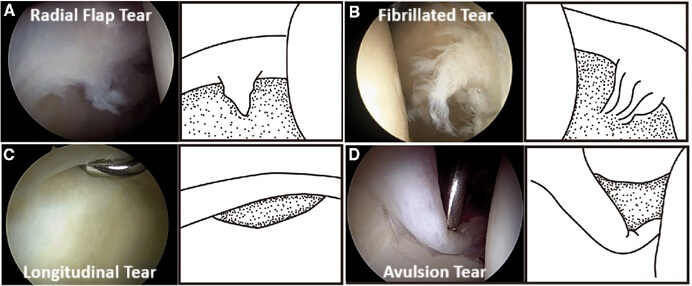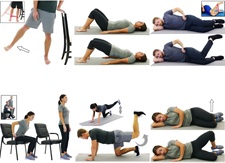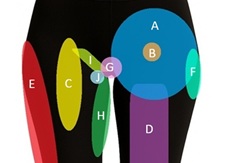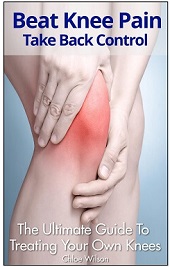- Home
- Hip Pain Diagnosis
- Torn Hip Labrum
Hip Labral Tear
Written By: Chloe Wilson, BSc(Hons) Physiotherapy
Reviewed by: KPE Medical Review Board
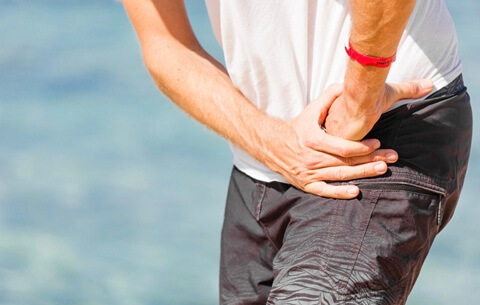
A hip labral tear is a relatively common cause of hip and groin pain, particularly in athletes and active individuals.
It occurs when there is damage to the ring of cartilage (labrum) that lines the outer rim of your hip joint socket.
This cartilage helps keep the joint stable and allows smooth movement. When it tears, it can cause discomfort, stiffness, and a catching sensation in the hip.
Here we look at the structure of the hip labrum, the different types of hip labral tears, common causes and symptoms, how tears are diagnosed and the different treatment options and recovery process.
What Is the Hip Labrum?
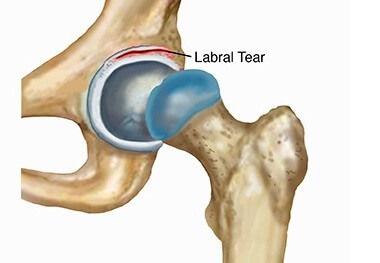
The hip labrum is a tough, flexible ring of cartilage that lines the rim of the acetabulum, the socket of the hip joint. It is 2-3mm thick and is typically thinner and wider at the front of the hip, thicker at the back.
The hip labrum serves several important roles:
- Stability: Deepens the socket by around 20% and holds the hip joint securely in good alignment for better joint stability
- Movement: facilitates full, smooth hip movement in all directions, particularly rotation
- Joint Lubrication: Acts as a seal to hold synovial fluid within the joint capsule and maintains fluid pressure which nourishes and reduces stress and friction through the joint
- Cushioning: Cushions the joint and helps absorb shock
The labrum has a limited blood supply which is mostly peripheral (at the edges) and can affect the healing potential.
Types of Torn Hip Labrum
There are two types of hip labral tear that can develop:
- Degenerative Labral
Fraying: The labrum gradually becomes worn and frayed over time, often without
a clear injury. Typically caused by repetitive stress or age-related changes
and develops gradually over time
- Acute Labral Tears: Sudden tearing of the labrum due to trauma, such as a fall, pivoting injury, or sports-related movement. Acute labrum tears are more likely to produce sharp, sudden pain and catching sensations and are more common in younger or athletic individuals.
Hip labral tears are generally classified based on their location:
- Anterior Labral Tear Hip: occur at the front of the hip and are the most common type
- Posterior Labral Tear Hip: occur at the back of the hip
Labrum tears are also classified by the pattern of the tear:
- Radial Flap Tears: Perpendicular tears extending inward from the labral edge, often forming a loose flap. Radial flap tears usually result from shear forces and are typically seen in traumatic injuries
- Radial Fibrillated Tears: These involve fraying and a roughened appearance of the labrum, usually at the edge. Fibrillated tears are usually seen in chronic or degenerative conditions
- Longitudinal Tears: These tears run along the length of the labrum and can be partial or full-thickness. They may occur in the main body or at the edge of the labrum (peripheral longitudinal tear). Longitudinal tears usually result from a combination of mechanical stress and degeneration
- Avulsion Tears: These occur when the labrum is pulled away from the bone, often as a result of high-force trauma or sudden twisting motions. They are commonly seen in athletes and may be associated with bone or cartilage injuries as well
What Causes Hip Labral
Tears?
A variety of factors can lead to a labral tear in the hip, including:
- Trauma: sudden impact e.g. fall or direct blow to the hip, particularly if the hip dislocates. Common with contact sports and car accidents
- Repetitive Motion: and hip overuse, common in sports like soccer, ballet and long distance running, or activities involving sudden pivoting or twisting e.g. golf or hockey
- Hip Impingement: extra bone growth on the femoral head (cam impingement) or the acetabulum (pincer impingement) causes abnormal contact during movement, which can damage the labrum through repeated compression or shearing forces
- Hip Dysplasia: where the hip socket is abnormally shallow, causing excessive movement of the femoral head. This instability increases the strain on the labrum, making it more vulnerable to tearing
- Degeneration: as people age, the labrum can become more brittle and less resilient. Degenerative tears often develop gradually and may be accompanied by arthritis, joint stiffness, or labral fraying
- Laxity: laxity in the joint capsule, ligaments or hip hypermobility causes the femoral head to move excessively, placing extra stress on the labrum
Anterior labral tears are usually caused by repetitive movements and gradual wear and tear from sports and activities, whereas posterior labral tears are usually caused by a traumatic injury such as a fall or high-impact injury.
Hip Labral Tear Symptoms
Torn hip labrum symptoms can vary but typically include:
- Deep pain in the hip or groin area, typically at the front. Often described as a constant dull ache with intermittent sharp pain with activity. The pain may refer down the front of the thigh
- Clicking, popping, locking, or catching sensations with hip movement – one of the most common symptoms of hip labrum tear
- Stiffness and reduced hip range of motion
- Functional limitations such as limping, difficulty on stairs and reduced walking distance
- Pain during twisting or pivoting movements
- Feeling of instability when standing or walking
Hip Labral Tear Diagnosis
Diagnosing a labral tear in the hip typically involves a combination of clinical assessment and imaging:
Medical History & Physical Exam
The doctor will evaluate your symptoms, past injuries, and physical activity. They will look at your hip and back movements, strength, flexibility and functional activities e.g. walking.
The will also perform special hip labral tear tests like the
- FADIR Test: combined hip Flexion, Adduction & Internal Rotation
- FABER Test: combined Flexion, Abduction, External Rotation –
An increase in hip pain with either of these tests indicates a possible labrum tear
Imaging Tests
An MRI arthrogram is the gold standard for visualizing hip labral tears. This specialized MRI uses contrast dye injected into the joint to provide detailed images of the labrum and surrounding structures.
Regular MRI and X-rays may also be used to rule out other conditions like arthritis or bone abnormalities
Diagnostic Injections
An injection of local anesthetic into the suspected hip joint labrum tear, under ultrasound guidance, can help confirm the diagnosis. If pain is relieved after the injection, it suggests the labrum is the source of discomfort.
Hip labral tear diagnosis is often tricky as the symptoms mimic those of a number of other hip conditions, so tears often go undiagnosed for quite a while.
Differential Diagnosis
Other conditions that can mimic a hip labral tear and cause front hip pain or upper thigh pain including:
- Hip Flexor Strain: Muscle injuries causing similar groin pain
- Groin Strain: Overstretching of one of the hip adductor muscles
- Hip Osteoarthritis: Degenerative joint disease with overlapping symptoms
- Snapping Hip Syndrome: Audible snapping with movement, often from tendons
- Hip Tendonitis: Irriation and inflammation of one of the hip tendons
- Hip Bursitis: Inflammation of one the small fluid-filled sacs around the hip
- Femoroacetabular Impingement (FAI): May coexist with or contribute to labral tears
Hip Labral Tear
Treatment
Treatment for a labral tear in the hip depends on the severity, location, and cause of the tear, as well as individual activity levels and goals.
Many people with mild to moderate labral tears in the hip benefit from conservative (non-surgical) care, especially if the tear is degenerative or not significantly limiting function. Conservative hip labral tear treatment usually involves:
- Activity Modification:
Avoiding activities that aggravate symptoms, such as running, pivoting, or
prolonged sitting, can help reduce strain on the hip
- Medications: Over-the-counter
non-steroidal anti-inflammatory drugs (NSAIDs) like ibuprofen or naproxen help
manage pain and inflammation
- Physical Therapy: Tailored
rehab programs and correcting movement patterns to reduce mechanical stress and.
Techniques such as joint mobilization or soft tissue release may relieve stiffness and muscle tightness, improving hip range of motion. Targeted massage can help reduce muscle tension and pain
in surrounding areas, like the hip flexors and glutes, which often become tight
in response to a labral injury
- Injections: a mixture or corticosteroid and anaesthetic can be injected into the hip to reduce inflammation and pain. If symptoms settle, it confirms the diagnosis of a hip labral tear
- Torn Labrum Hip Exercises: Rehabilitation exercises can help improve strength and stability:
- Hip Flexor And Extensor Stretches: to maintain flexibility
- Core Strengthening: like planks and bridges to support pelvic alignment
- Hip Strengthening Exercises: clamshells, side-lying leg lifts, and resistance band work
- Balance Training: to restore coordination and reduce strain

Surgical Treatment
Hip labral tear surgery may be recommended if symptoms persist after 8–12 weeks of conservative management or if the labrum tear is more severe.
The most common type of hip labral tear surgery is a hip arthroscopy. This minimally invasive procedure involves making small incisions around the hip and inserting surgical tools and a camera (arthroscope) to visualize the joint. The surgeon may:
- Repair the torn labrum by suturing it back to the bone (labral refixation)
- Debride the labrum by trimming frayed or loose parts
- Address underlying causes such as femoroacetabular impingement (FAI) or bone abnormalities e.g. removing bone spurs or reshaping bones
- In cases where the labrum is too damaged to repair, it may be reconstructed using a graft (from the patient or donor tissue), known as a hip labral reconstruction
Hip labrum surgery recovery typically involves a structured rehabilitation program and gradual return to activity. Most people see significant improvements in pain and function within 3–6 months post-op.
Hip Labrum Recovery
Hip labral tear recovery depends on the extent of the tear and treatment used:
Mild to moderate cases typically improve in a few weeks with rest, medication and physical therapy, with most people making a full recovery in 3-4 months.
If you need surgery, it may take 4-6 months to return to your usual activities.
With or without surgery, rehab is essential for hip labral tears, comprising of strengthening and stability exercises, and can take several months. Ongoing physical therapy helps restore strength and range of motion so you can return to your usual activities without ongoing problems.
Hip Labral Tear Summary
A hip labral tear can cause significant discomfort and limit mobility, but with early diagnosis and proper treatment, most people can return to their usual activities.
Common signs of a torn hip labrum include deep aching pain and clicking in the hip, stiffness and functional limitation. Labrum tears are often associated with femoroacetabular impingement.
Conservative treatments and specific hip strengthening exercises and stretches are often effective, and surgical options exist for more severe cases. Understanding the symptoms and causes is key to preventing long-term complications and promoting full recovery.
Hip labrum tears are just one possible cause of outer hip pain, front hip pain, inner thigh pain and upper thigh pain, and you may also be interested in the following articles:
- Hip Bursitis
- Groin Strain
- Hip Impingement
- Hip Flexor Strain
- Hip Flexor Pain
- Hip Tendonitis
- Hip Muscle Anatomy
- Pain Above The Knee
- Swelling Above The Knee
Related Articles
Hip Strengthening
September 24, 2025
Hip Pain Diagnosis
September 16, 2025
Improve Flexibility
September 30, 2025
Medical & Scientific References
- A Comprehensive Review Of Hip Labral Tears. Current Reviews In Musculoskeletal Medicine
- The Clinical Outcomes Of Arthroscopic Hip Labral Repair. A Comparison Between Athletes And Non-Athletes. Journal Of Hip Preservation Surgery
- The Imaging Evaluation Of Acetabular Labral Lesions. Journal Of Orthopaedics & Traumatology
Last Updated: September 16th, 2025
Next Review Due: September 16th, 2027
